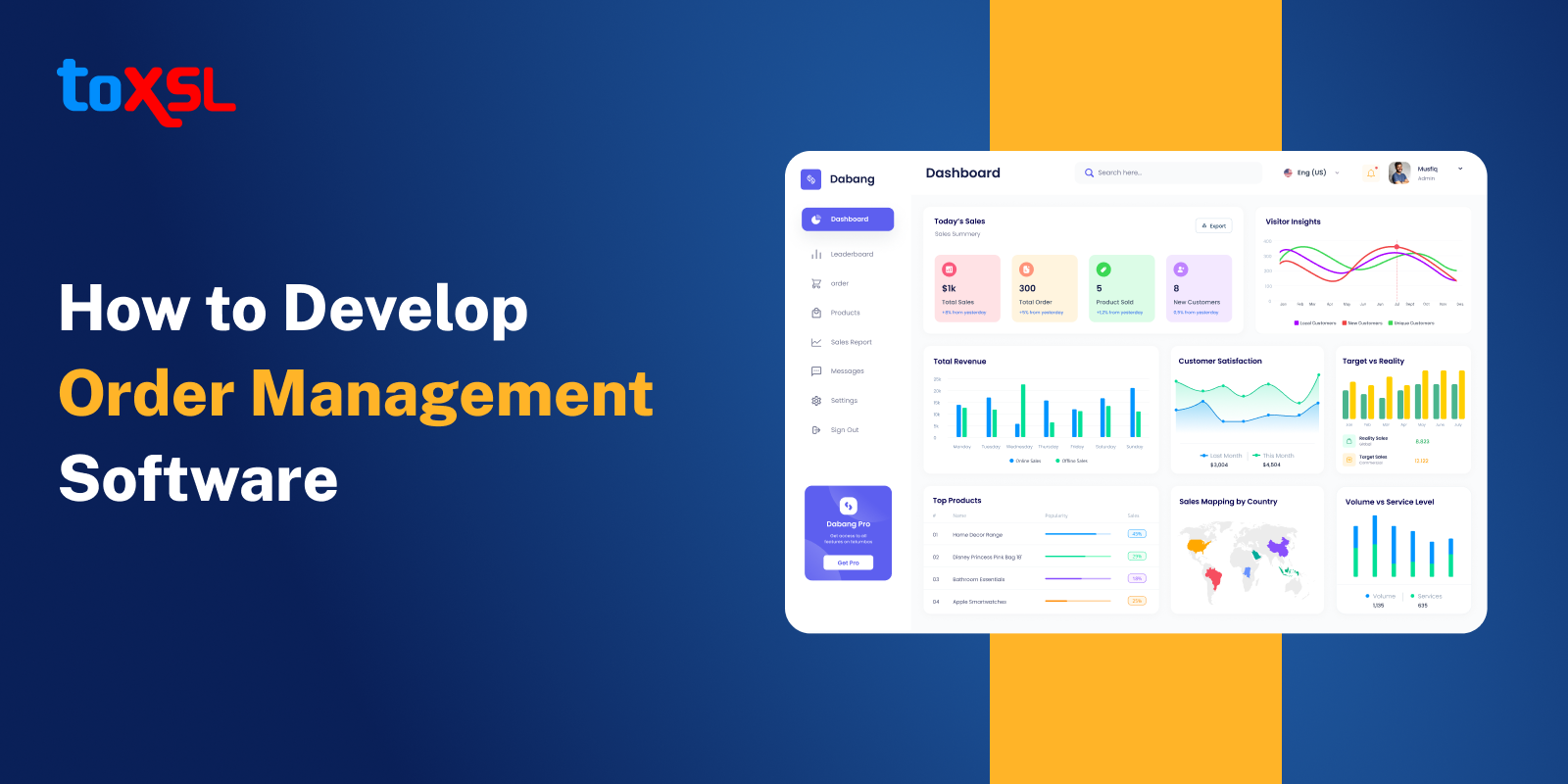- Apr 08, 2025
Share this post on:

Are you tired of managing multiple orders? Looking for an easy way out to manage numerous orders at once? The demand for numerous orders at once has created the immense need for the order management software. What is order management software? Order management software handles the processes of placing, tracking, and managing orders.
However, developing order management software is not an easy task. It comes with its own development challenges. How do businesses overcome development challenges? The solution is to hire a mobile app development company and tell them your requirements related to order management software. Let us now go deeper into the blog and learn about order management software in detail.
Steps to Develop an Order Management Software
Developing an order management software (OMS) involves several critical steps to ensure it meets business needs effectively. Here’s a comprehensive guide outlining the process:
1. Initial Consultation and Requirement Analysis
• Gather Requirements: Collaborate with stakeholders to identify necessary features and functionalities. This phase should include a cost benefit analysis to evaluate potential development partners or internal capabilities.
• Define Specific Needs: Assess current processes and define specific requirements, considering factors like order volume, product complexity, and scalability.
2. Design and Architecture
• Create System Design: Develop a detailed system design that includes architecture, database structure, and user interface. Focus on scalability and performance to accommodate future growth.
• User Experience (UX) Prototyping: Design role-specific UX/UI prototypes that facilitate ease of use for different user roles within the organization.
3. Project Planning
• Implementation Planning: Establish a project management team to outline deliverables, scope, and key performance indicators (KPIs). This planning should also include risk assessment and resource estimation.
• Timeline Creation: Develop a realistic timeline for the project, considering the complexity of integrations and the functionalities required.
4. Development Phase
• Coding: Transform the design into a functional system through coding. Utilise modern programming languages and frameworks while adhering to coding best practices.
• Agile Methodology: Implement an agile development approach to allow for flexibility and iterative improvements throughout the development process.
5. Testing
• Conduct Various Tests: Perform unit testing, integration testing, and system testing to identify and resolve bugs or issues. User acceptance testing is also crucial to ensure the system meets user requirements.
• Testing with Dummy Data: Use dummy data for testing to avoid impacting actual orders during the testing phase.
6. Integration and Data Migration
• System Integration: Ensure seamless integration with existing systems such as ERP, CRM, and accounting software. Conduct integration testing to verify connections between systems.
• Data Migration: Migrate existing sales order data from previous systems or spreadsheets into the new OMS, ensuring data integrity throughout the process.
7. Deployment
• Deployment Planning: Prepare for deployment by developing a strategy that addresses potential issues during the transition to the production environment.
• Training Users: Provide comprehensive training for users on how to navigate and utilise the new system effectively. This training should occur during the testing phase to familiarize users with functionalities.
8. Post-Deployment Support
• Ongoing Support: After deployment, offer support to address any issues that arise as users begin utilizing the system in real-time operations.
• Regular Updates: Plan for regular updates and maintenance of the OMS to adapt to changing business needs and technological advancements.
Standard Steps in Order Management Solutions
The OMS process is closely linked to the completion of daily tasks and overall customer satisfaction. Typically, the order management process includes order placement, fulfilment, inventory management, shipping, post-sales follow-up, integration, and reporting.
While most order management solutions adhere to a standard seven-step process, these steps can be customized to meet specific business needs.
1. Order Placement: Customers can place orders through various channels, including online stores and mobile apps. The OMS processes these orders and stores them in a centralized database.
2. Order Fulfilment: After an order is accepted, the work order management software manages the fulfilment process. This involves selecting items from the company’s inventory, packing, labelling, and preparing them for shipment.
3. Inventory Management: The inventory and order management software handles inventory in several ways: some products are pre-sold, such as those for fall-winter collections; consignment inventory, though less common, is also managed; and replenishment orders are generated based on seasonal forecasts.
- SingleOrder: For single-item orders, the system checks the availability of each item and updates inventory levels accordingly.
- Batch Picking: Orders from multiple clients are combined for efficiency during the picking process.
- Zone Picking: This method divides the warehouse into designated areas, assigning pickers to specific zones to minimize travel time.
- Wave Picking: This approach consolidates orders that can be processed simultaneously to enhance efficiency.
4. Shipping: The online order management system ensures accurate shipping by:
- Verifying that the correct quantity is included in the shipment.
- Selecting the appropriate box size to avoid unnecessary shipping costs.
- Ensuring that items are well packaged and securely loaded into the delivery vehicle to prevent damage.
- Tracking orders and providing customers with updates so they can monitor their order status.
5. Post-Sales Follow-Up: Shipment outcomes can be sent to the integrated order management system, which may trigger automated follow-up emails to gather customer feedback or recommend additional products or refunds, along with inventory updates.
6. Integration with Other Systems: The OMS offers varying levels of integration with other retail management software solutions, such as accounting software, CRM systems, and shipping carriers, ultimately streamlining operations and improving efficiency.
7. Reporting and Analytics: Equipped with reporting and analytics capabilities, the OMS helps businesses track key metrics, including order processing times, inventory turnover rates, and customer satisfaction levels.
Types of Custom Order Management System
In this section, let us now discuss the types of order management systems:
1. Cloud-based OMS: Did you know the market for cloud-based OMS solutions is projected to expand at a compound annual growth rate (CAGR) of 13.3% from 2021 to 2028, driven by their scalability and cost efficiency? A cloud-based Order Management System (OMS) operates on a remote server that can be accessed online. It streamlines and automates order management processes for businesses. Additionally, it integrates with other systems, reducing the need for extensive investment in in-house computer infrastructure.
2. Inventory OMS: Large companies with diverse operations use inventory Order Management Systems (OMS). Inventory OMS collaborates seamlessly with various systems such as accounting, marketing, supply chain, sales, and customer service. When all components are integrated, it becomes an excellent option for those looking to maximize automation. It efficiently manages numerous orders simultaneously, interfaces with multiple systems, and provides sophisticated analytics and reporting capabilities.
3. Integrated OMS: An integrated Order Management System (OMS) integrates all operations into a single platform, allowing businesses to synchronize customer data across various sales channels and analyze it in real-time. This OMS also facilitates connections with other businesses through systems such as Enterprise Resource Planning (ERP), Customer Relationship Management (CRM), and additional inventory management solutions.
4. E-commerce OMS: This particular type of Order Management System (OMS) is designed specifically for e-commerce businesses and online retailers. Known as e-commerce order management, it manages the behind-the-scenes activities associated with processing and fulfilling online orders. This includes a range of tasks such as order routing, printing shipping labels, managing returns, and overseeing subscriptions.
5. Retail OMS: Retail Order Management System (OMS) is tailored for retailers operating physical stores or online shops. A retail OMS enables businesses to access real-time updates on their inventory levels across various sales channels. It allows businesses to sell their products. Furthermore, it provides the ability to monitor sales performance and gain valuable insights into their product offerings.
Benefits of Developing the Order Management Software
Order management software can transform businesses by streamlining processes, enhancing customer satisfaction, and increasing efficiency. If you're interested in discovering how investing in order management software can benefit your organization, take a look at these compelling reasons.
1. Enhanced Order Accuracy and Speed: Implementing OMS leads to improved order accuracy by automating data entry and reducing human errors. This automation speeds up the order processing cycle, allowing businesses to fulfil orders more quickly and efficiently. Real-time updates ensure that all stakeholders have access to the most current information, which minimizes delays and enhances customer satisfaction.
2. Real-time Inventory Visibility: Real-time inventory visibility is crucial for effective order management. With an OMS, businesses can track inventory levels across all locations and channels, ensuring that stock availability is accurately reflected in real time. This capability helps prevent overselling and stockouts, allowing companies to meet customer demands promptly while optimizing inventory levels. It also facilitates better resource allocation and reduces carrying costs associated with excess inventory.
3. Data-driven Decision Making: An effective OMS provides valuable insights through data analytics, enabling businesses to make informed decisions. By analyzing order patterns, inventory turnover rates, and customer preferences, companies can forecast demand more accurately and adjust their strategies accordingly. This data-driven approach enhances operational efficiency and supports strategic planning, ultimately leading to better financial performance.
4. Scalability and Adaptability: Order management software is designed to grow with your business. As order volumes increase or new sales channels are introduced, an OMS can easily adapt to changing needs without requiring a complete overhaul of existing systems. This scalability ensures that businesses can continue to operate smoothly during periods of growth or transition, making it a long-term solution for evolving market demands.
Cost to Develop an Order Management Software
The cost to develop order management software in Australia can vary significantly based on various factors, including complexity, features, and the expertise of the development team. Here are some key insights:
1. General Cost Range: The typical cost to purchase order software development ranges from $40,000 to $250,000. This variation is influenced by the system's complexity, specific functionalities required, and the level of customization needed to meet business goals.
2. Basic vs. Complex Systems: Basic OMS solutions may fall at the lower end of the spectrum (around $8,000 to $13,000), while more complex systems with advanced features can exceed $200,000. High-end custom solutions can reach costs between $200,000 and $400,000 depending on integration needs and other specifications.
Wrapping Up
Investing in eCommerce order management software is a strategic decision that can yield substantial returns. It enhances customer satisfaction, boosts revenue, and streamlines business processes. For entrepreneurs, this sector presents a compelling opportunity to leverage the growing demand for tech-driven and efficient solutions in today’s business landscape.
Creating order management software can be transformative for your business. So why wait? Consult ToXSL Technologies, a leading software development company, to turn your vision into reality. Request a quote.
FAQs
Q1. What is order management software and why is it important?
Order management software helps businesses track sales, manage inventory, process orders, and handle customer data in one system. It improves accuracy, reduces manual work, and ensures timely order delivery, making it essential for efficient business operations.
Q2. What are the key features of effective order management software?
Key features include real-time order tracking, inventory control, multi-channel integration, automated invoicing, customer management, and reporting tools. At ToXSL Technologies, we customize features based on your business needs.
Q3. How long does it take to develop order management software?
The development time depends on the complexity and features required. A basic system may take 4–6 weeks, while an advanced solution with integrations could take longer. ToXSL Technologies provides a detailed timeline after understanding your project scope.












